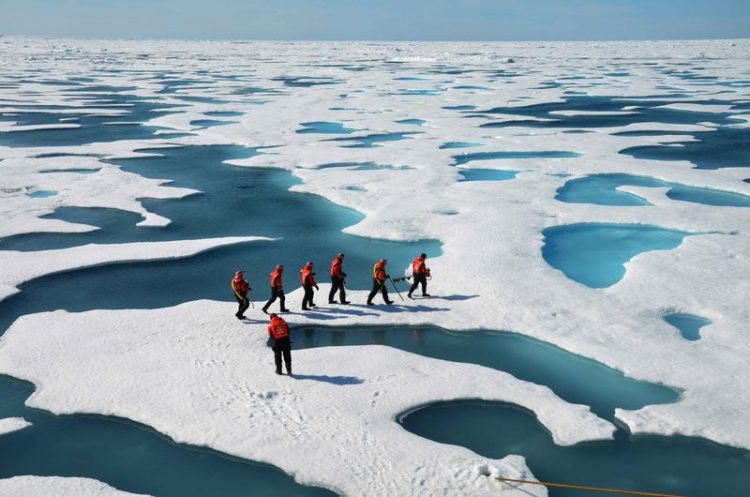Research priorities for the Arctic have been defined

Scientists in the field Photo: Don Perovich
The leading international Arctic research organisations have set common scientific objectives for the coming decade. The indigenous peoples of the Arctic were also involved in this process. Under the auspices of the International Arctic Science Committee (IASC), which is based at the Alfred Wegener Institute in Potsdam, they are about to submit a report that sets out the path for a jointly conceived and solution-oriented research agenda on the sustainable development of the Arctic and beyond.
The Arctic is the region on earth that reacts most sensitively and most quickly to changes in climate. However, what happens in the Arctic does not stay in the Arctic. The decrease in the sea ice cover, the thawing of the permafrost, snow and glaciers have an impact on the global climate system. Furthermore, growing economic and geopolitical interests in the Arctic do not just cause changes in the Arctic itself, but also far beyond its borders.
“The goal of science has to be to generate knowledge and to pass it on to decision-makers, so that they can be prepared for these changes and not only react to them”, says Dr Volker Rachold, Executive Secretary of the IASC at the Alfred Wegener Institute, Helmholtz Centre for Polar and Marine Research.
The scientific report will be presented at the beginning of March at the summit meeting of Arctic researchers, the Arctic Science Summit Week – ASSW, in Fairbanks (Alaska). In addition to questions and focal points, the report will also show how science should tackle these issues.
“As we developed the scientific objectives, three main priorities for future Arctic research clearly emerged”, says Rachold. The first priority is to explore the role of the Arctic within the global climate, economic and geopolitical system. Secondly, the research organisations are planning to add better models and forecasts about future climate development in the Arctic and the impact on the Arctic eco-systems to their agenda. Thirdly, we need a better understanding of the vulnerability as well as the resilience of the Arctic environment and society as a scientific basis for the sustainable development of the Arctic.
A significant conclusion of the study was that, in order to achieve these goals, both the indigenous and local population of the Arctic and the other stakeholders must be involved in formulating the research questions. “We will set out the path for a jointly conceived and solution-oriented research agenda on the sustainable development of the Arctic and beyond”, IASC Executive Secretary summarises.
The original report, “Integrating Arctic Research – a Roadmap for the Future” of the 3rd International Conference on Arctic Research Planning ICARP III is available for download at: http://icarp.iasc.info/
Notes for Editors:
Your contact persons are Dr Volker Rachold (tel.: 0331 288-2212; e-mail: Volker.Rachold(at)awi.de) as well as Dr Folke Mehrtens at the press office of the Alfred Wegener Institute (tel.: 0471 4831-2007; e-mail: Folke.Mehrtens(at)awi.de).
Please find printable images in the online version of this press release: http://www.awi.de/nc/en/about-us/service/press.html
The Alfred Wegener Institute, Helmholtz Centre for Polar and Marine Research (AWI) conducts research in the Arctic, Antarctic and oceans of the high and mid-latitudes. It coordinates polar research in Germany and provides major infrastructure to the international scientific community, such as the research icebreaker Polarstern and stations in the Arctic and Antarctica. The Alfred Wegener Institute is one of the 18 research centres of the Helmholtz Association, the largest scientific organisation in Germany.
http://icarp.iasc.info/ A Roadmap to the Future
Media Contact
All latest news from the category: Earth Sciences
Earth Sciences (also referred to as Geosciences), which deals with basic issues surrounding our planet, plays a vital role in the area of energy and raw materials supply.
Earth Sciences comprises subjects such as geology, geography, geological informatics, paleontology, mineralogy, petrography, crystallography, geophysics, geodesy, glaciology, cartography, photogrammetry, meteorology and seismology, early-warning systems, earthquake research and polar research.
Newest articles

A ‘language’ for ML models to predict nanopore properties
A large number of 2D materials like graphene can have nanopores – small holes formed by missing atoms through which foreign substances can pass. The properties of these nanopores dictate many…

Clinically validated, wearable ultrasound patch
… for continuous blood pressure monitoring. A team of researchers at the University of California San Diego has developed a new and improved wearable ultrasound patch for continuous and noninvasive…

A new puzzle piece for string theory research
Dr. Ksenia Fedosova from the Cluster of Excellence Mathematics Münster, along with an international research team, has proven a conjecture in string theory that physicists had proposed regarding certain equations….



